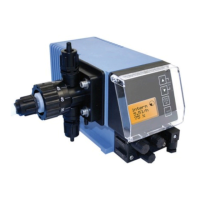417101774_EMP_KKS_E60_E.doc - 64 - Rev. 8-03.10
12 Operating faults
12.1 Metering warning messages (display)
If external signals are no longer being processed and the output signals (empty, fault) are
switched off, the following error messages can be shown on the display of the metering
pump:
Display Meaning Effect Cause Remedy
Fig. 12.1
reserve report
(flashing)
pump continues
running
low-level advance
warning active
Refill the metering medium
Fig. 12.2
empty report pump is stopped empty report active Refill the metering medium
Fig. 12.3
metering lock
(only possible if this
is configured)
pump is stopped no external enable of
the pump
Activate external enable or
deactivate the metering
lock in the configuration
menu.
(See chapter 10.3.7
)
Fig. 12.4
Indicator in
operation mode
4..20 mA flashes
standard signal
monitoring
responds
pump is stopped standard signal is under
3mA or cable to
standard signal
connection is broken
check the standard signal
or cable
Fig. 12.5
--.-
standard signal is
above 23.0 mA
pump runs in
continuous
operation
standard signal exceeds
the display range
reduce the standard signal
12.2 Alarm messages (display)
Display Meaning Effect Cause Remedy
Fig. 12.6
alarm
failure 1
permanent stroke
!
Motor is
running
uncontrolled in
continuous
operation
over dosage power electronic
failure
replace PC-Board
backpressure too high reduce pressure
valve closed at
pressure side
open valve
Fig 12.7
alarm
failure 2
no stroke
!
Motor is not
running despite
of rotating
dosing symbol.
no metering
Motor
overheated/damaged
power electronic
failure
cool of the motor,
or change
replace PC-board
Fig. 12.8
alarm
failure 3
motor control
!
motor in
continuous
operation
without request
continuous
metering
optical sensor polluted
PC-board fault
Plug connection from
gear to PC-Board
interrupted
Send in pump
control optical sensor
connection
tube fault check the tubes
diaphragm fault check the diaphragm
Fig. 12.9
alarm
failure 4
oval gear meter
!
error in
evaluating the
metering
monitoring or
oval gear meter
pump meters too
little or too much
backpressure too high
or too low
check the backpressure

